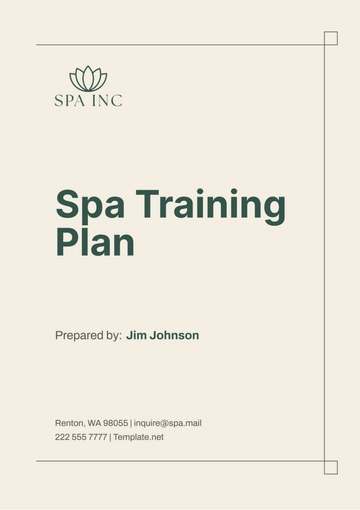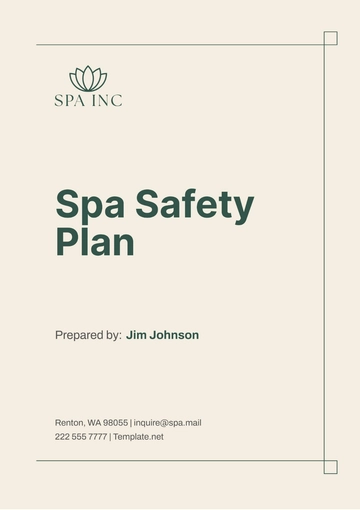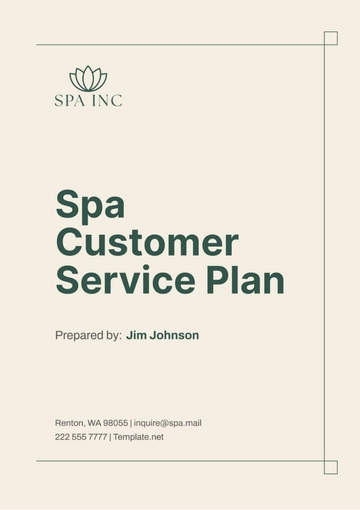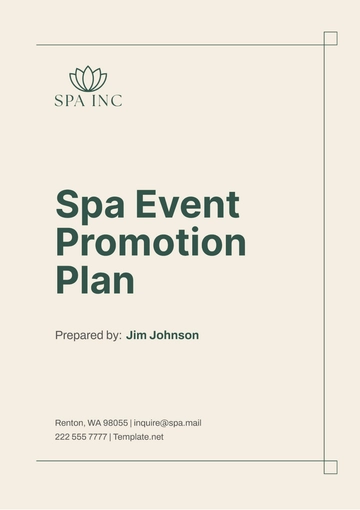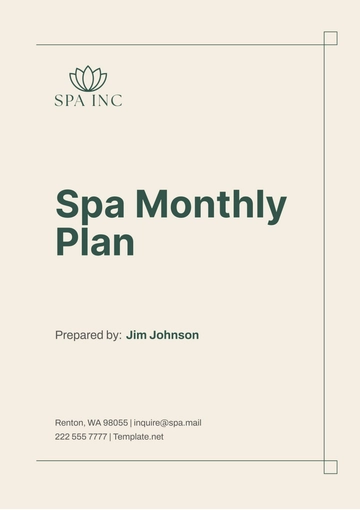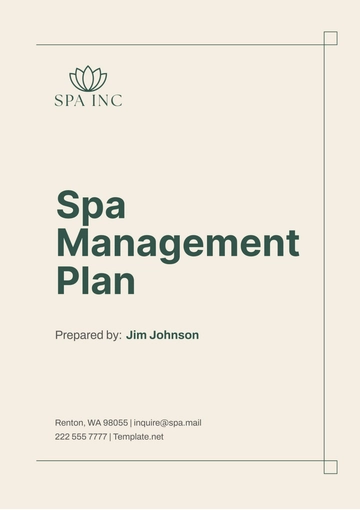Free Spa Training Plan
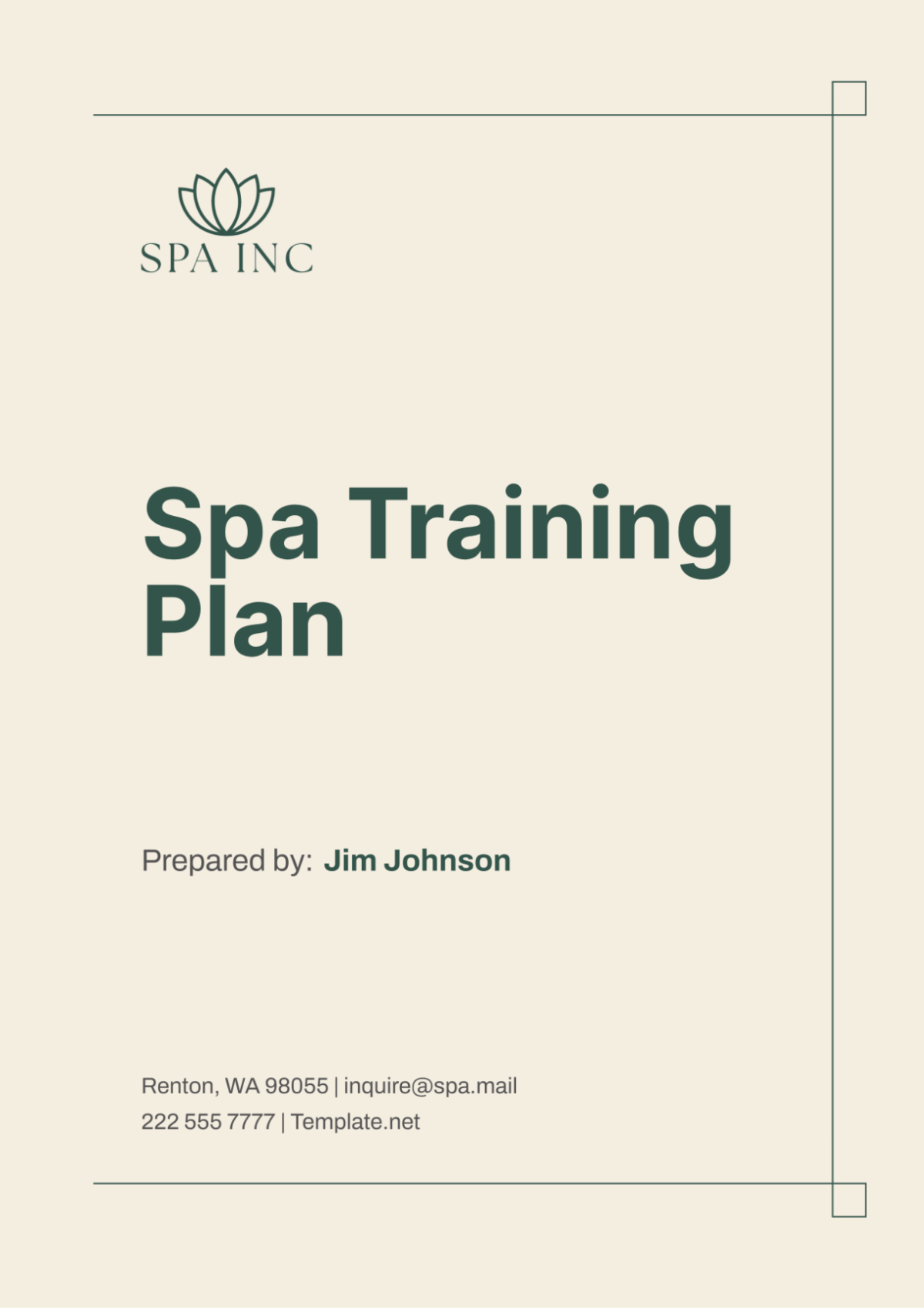
I. Introduction
A. Purpose of the Training Plan
The purpose of the Spa Training Plan for [Your Company Name] is to ensure that all spa staff members are equipped with the necessary skills and knowledge to deliver exceptional service to our clients. This training plan aims to enhance the professional competencies of our team, focusing on both technical and soft skills required in a high-quality spa environment. By providing structured training, [Your Company Name] seeks to maintain its reputation for excellence and improve overall client satisfaction.
B. Scope
This training plan covers all employees at [Your Company Name], including therapists, receptionists, and management staff. It focuses on various aspects of spa operations, from customer service and technical skills to health and safety protocols. The training plan is designed to address the unique needs of each role within the spa, ensuring comprehensive development across the board.
II. Training Needs Analysis
A. Skills Assessment
To develop an effective training plan, it is crucial to conduct a thorough skills assessment of the current spa staff. This assessment involves evaluating the existing competencies and identifying areas that require improvement. The assessment will be carried out through a combination of performance reviews, client feedback, and direct observation by senior staff.
A skills matrix will be used to document the findings of the assessment. The matrix will list the essential skills required for each role and rate the proficiency of each staff member on a scale from 1 to 5, with 1 being novice and 5 being expert. This approach will provide a clear picture of where training is needed the most.
Role | Skill | Employee 1 | Employee 2 | Employee 3 | Employee 4 |
|---|---|---|---|---|---|
Therapist | Massage Techniques | 4 | 3 | 2 | 5 |
Skin Care Treatments | 5 | 4 | 3 | 4 | |
Receptionist | Customer Service | 3 | 4 | 5 | 4 |
Booking Management | 4 | 3 | 5 | 4 | |
Manager | Team Leadership | 5 | 4 | 3 | 5 |
Conflict Resolution | 4 | 3 | 4 | 5 |
B. Training Requirements
Based on the skills assessment, specific training requirements will be identified for each role. The goal is to address skill gaps and enhance the overall competency of the team. For example, therapists may need additional training in advanced massage techniques, while receptionists might benefit from improved customer service skills. Managers may require further development in leadership and conflict resolution.
The training requirements will be prioritized based on the impact on spa operations and client satisfaction. High-priority areas will be addressed first to ensure immediate improvements in service quality.
III. Training Objectives
A. Overall Objectives
The overall objective of the Spa Training Plan for [Your Company Name] is to create a highly skilled and knowledgeable team capable of delivering exceptional spa services. This involves enhancing both technical and soft skills to meet the evolving needs of our clients. By achieving these objectives, [Your Company Name] aims to maintain its competitive edge in the spa industry.
B. Specific Objectives
The specific objectives of the training plan include:
Customer Service Enhancement: Improve the ability of staff to interact positively with clients, handle complaints effectively, and ensure a memorable spa experience.
Technical Skill Mastery: Ensure that all therapists are proficient in the latest massage techniques, skin care treatments, and the use of spa equipment.
Health and Safety Compliance: Train staff on the importance of hygiene, sanitation, and emergency procedures to ensure a safe environment for both clients and employees.
Soft Skills Development: Enhance communication, teamwork, and time management skills to improve overall spa operations and staff efficiency.
IV. Training Content
A. Customer Service Training
Customer service is a critical component of the spa experience at [Your Company Name]. This training module focuses on developing the skills necessary to provide outstanding service and handle client interactions with professionalism and empathy. The content includes:
Client Interaction Techniques: Staff will learn how to greet clients warmly, conduct consultations to understand their needs, and provide personalized service recommendations. Role-playing scenarios will be used to practice these interactions and build confidence.
Handling Complaints and Feedback: Training will cover strategies for managing client complaints and turning negative experiences into positive outcomes. Staff will learn how to listen actively, empathize with clients, and offer appropriate solutions. Feedback mechanisms will be established to continuously improve service quality.
B. Technical Skills Training
The technical skills training module is designed to ensure that all therapists at [Your Company Name] are proficient in the latest spa treatments and techniques. This includes hands-on training and theoretical knowledge to ensure comprehensive understanding and application.
Massage Therapy Techniques: Therapists will receive training in various massage modalities, including Swedish, deep tissue, hot stone, and aromatherapy. Emphasis will be placed on mastering the techniques, understanding the benefits, and tailoring treatments to individual client needs.
Skin Care Treatments: Training will cover a range of skin care treatments, including facials, exfoliations, and body wraps. Staff will learn about different skin types, product ingredients, and the benefits of each treatment. Practical demonstrations and supervised practice sessions will ensure proficiency.
Use of Spa Equipment: Staff will be trained on the proper use and maintenance of spa equipment, such as steam rooms, saunas, and hydrotherapy tubs. This includes understanding safety protocols, troubleshooting common issues, and ensuring optimal performance.
C. Health and Safety Training
Health and safety are paramount in a spa environment, and [Your Company Name] is committed to maintaining the highest standards. This training module covers hygiene practices, sanitation protocols, and emergency procedures.
Hygiene and Sanitation Protocols: Staff will be trained on the importance of maintaining a clean and hygienic spa environment. This includes proper handwashing techniques, sterilization of equipment, and regular cleaning schedules. Training will also cover the use of personal protective equipment (PPE) and handling of hazardous materials.
Emergency Procedures and First Aid: Staff will learn how to respond to emergencies, such as fires, medical incidents, and evacuations. First aid training will be provided, including CPR, wound care, and handling of allergic reactions. Regular drills will be conducted to ensure preparedness.
D. Soft Skills Training
In addition to technical skills, soft skills are essential for effective spa operations. This training module focuses on developing communication, teamwork, and time management skills.
Communication and Interpersonal Skills: Training will cover effective communication techniques, including active listening, clear articulation, and non-verbal cues. Staff will learn how to interact positively with clients and colleagues, fostering a supportive and collaborative environment.
Time Management and Organizational Skills: Staff will be trained on how to manage their time effectively, prioritize tasks, and stay organized. This includes techniques for scheduling appointments, managing workloads, and minimizing downtime. The goal is to improve efficiency and ensure smooth spa operations.
V. Training Methods
A. On-the-Job Training
On-the-job training is a practical approach that allows staff to learn by doing. This method involves hands-on experience under the guidance of experienced trainers and mentors. Key components include:
Practical Demonstrations: Trainers will demonstrate various spa treatments and procedures, allowing staff to observe and learn. This includes detailed explanations of techniques, safety protocols, and best practices.
Shadowing Experienced Staff: New employees will have the opportunity to shadow experienced staff members, observing their interactions with clients and learning from their expertise. This approach provides real-world experience and helps build confidence.
B. Classroom Training
Classroom training provides a structured environment for learning theoretical knowledge and practicing skills. This method includes interactive workshops, seminars, and role-playing activities.
Workshops and Seminars: Staff will participate in workshops and seminars led by industry experts. These sessions will cover topics such as customer service, technical skills, and health and safety protocols. Interactive activities and group discussions will enhance learning.
Role-Playing Activities: Role-playing scenarios will be used to simulate real-life situations, allowing staff to practice their skills in a controlled environment. This includes client interactions, handling complaints, and performing treatments. Feedback will be provided to help staff improve their performance.
C. Online Training
Online training offers flexibility and accessibility, allowing staff to learn at their own pace. This method includes e-learning modules, webinars, and video tutorials.
E-Learning Modules: Staff will have access to online courses covering various topics, such as customer service, technical skills, and health and safety. These modules include quizzes and assessments to test knowledge and ensure comprehension.
Webinars and Video Tutorials: Live webinars and recorded video tutorials will be used to provide additional training and support. These resources will cover new techniques, industry trends, and best practices. Staff can revisit these materials as needed to reinforce their learning.
D. Training Schedule
To ensure effective implementation of the training plan, a detailed training schedule will be developed. The schedule will outline the timeline for training sessions, the frequency and duration of each module, and the assignment of trainers and facilitators.
Overview: The training schedule will be designed to accommodate the operational needs of the spa while ensuring comprehensive training for all staff members. Training sessions will be scheduled during non-peak hours to minimize disruption to spa operations.
Detailed Schedule: A calendar of training events will be created, specifying the dates, times, and locations of each session. The schedule will also include the names of trainers and facilitators responsible for conducting the sessions.
VI. Training Materials and Resources
A. Materials
To ensure the effective delivery of training, [Your Company Name] will utilize a variety of training materials tailored to the specific needs of each module. These materials include training manuals, handouts, multimedia resources, and practical tools.
Training Manuals and Handouts: Comprehensive training manuals will be developed for each module, providing detailed information on procedures, techniques, and best practices. Handouts will summarize key points and serve as quick reference guides for staff. These materials will be updated regularly to reflect new industry standards and innovations.
Multimedia Resources: Multimedia resources such as videos, slideshows, and interactive presentations will be used to enhance the learning experience. These resources will cover various topics, including customer service techniques, technical skills, and health and safety protocols. Visual and auditory aids will help reinforce key concepts and cater to different learning styles.
Practical Tools: Practical tools such as treatment charts, checklists, and assessment forms will be provided to staff to facilitate hands-on learning and performance tracking. These tools will support staff in applying their knowledge in real-world scenarios and ensuring consistency in service delivery.
B. Resources
In addition to training materials, [Your Company Name] will allocate various resources to support the training program. These resources include training rooms, equipment, and access to online platforms.
Training Rooms and Equipment: Dedicated training rooms equipped with necessary facilities will be made available for classroom and practical sessions. These rooms will be equipped with audiovisual equipment, massage tables, skincare devices, and other tools required for hands-on training. Regular maintenance and updates of the equipment will be ensured to provide a safe and effective learning environment.
Online Training Platforms: Staff will have access to online training platforms that offer a range of e-learning modules, webinars, and video tutorials. These platforms will enable staff to learn at their own pace and revisit training materials as needed. Online assessments and quizzes will be used to track progress and ensure comprehension.
VII. Trainer Qualifications
A. Selection of Trainers
The success of the training program relies heavily on the qualifications and expertise of the trainers. [Your Company Name] will select trainers based on their experience, knowledge, and ability to effectively communicate and engage with staff. Trainers will be chosen from both internal and external sources to provide a balanced perspective.
Criteria for Choosing Trainers: Trainers will be selected based on their proficiency in the relevant areas of training, proven track record of delivering effective training, and ability to motivate and inspire staff. Internal trainers will be chosen for their deep understanding of [Your Company Name]'s operations and culture, while external trainers will be brought in for specialized topics requiring additional expertise.
B. Trainer Training
To ensure consistency and quality in training delivery, [Your Company Name] will implement a "train-the-trainer" program. This program will equip trainers with the skills and knowledge needed to deliver effective training sessions and assess staff performance accurately.
Train-the-Trainer Programs: Trainers will undergo a comprehensive training program covering instructional techniques, assessment methods, and feedback mechanisms. They will learn how to create engaging training materials, facilitate interactive sessions, and evaluate trainee progress. Continuous development opportunities will be provided to keep trainers updated on the latest industry trends and best practices.
Continuous Development for Trainers: Regular workshops and seminars will be organized for trainers to enhance their skills and stay current with advancements in the spa industry. Trainers will also participate in industry conferences and networking events to gain new insights and share knowledge with peers.
VIII. Evaluation and Assessment
A. Assessment Methods
To measure the effectiveness of the training program and ensure that staff are meeting the desired competencies, [Your Company Name] will implement a robust evaluation and assessment framework. This framework will include pre-and post-training assessments, practical evaluations, and simulations.
Pre- and Post-Training Assessments: Pre-training assessments will be conducted to establish a baseline of staff knowledge and skills. These assessments will help identify specific training needs and tailor the program accordingly. Post-training assessments will be used to measure the improvement in skills and knowledge, providing a clear indication of training effectiveness.
Practical Evaluations and Simulations: Practical evaluations will involve staff demonstrating their skills in real-world scenarios under the supervision of trainers. Simulations will be used to recreate common spa situations, allowing staff to practice and refine their skills. Trainers will provide feedback and guidance to help staff improve their performance.
B. Feedback Mechanisms
Collecting feedback from trainees and trainers is essential for continuous improvement of the training program. [Your Company Name] will establish formal feedback mechanisms to gather insights and suggestions.
Collecting Feedback from Trainees: Regular surveys and feedback forms will be distributed to trainees to gather their opinions on the training content, delivery, and overall experience. This feedback will be analyzed to identify areas for improvement and make necessary adjustments to the training program.
Trainer Evaluations: Trainers will also provide feedback on the trainees' performance, identifying strengths and areas for development. This feedback will be used to tailor ongoing training and support for individual staff members.
C. Performance Metrics
To objectively measure the impact of the training program, [Your Company Name] will establish performance metrics and track progress over time. These metrics will include both quantitative and qualitative indicators.
Measuring Training Effectiveness: Key performance indicators (KPIs) such as client satisfaction scores, service quality ratings, and employee retention rates will be monitored to assess the effectiveness of the training program. Regular analysis of these metrics will help identify trends and make data-driven decisions.
Tracking Improvement in Skills and Performance: Individual performance metrics will be tracked for each staff member, including their progress in specific skills and overall job performance. Regular performance reviews will be conducted to ensure continuous development and address any areas of concern.
IX. Continuous Improvement
A. Ongoing Training
Continuous improvement is a core principle at [Your Company Name], and ongoing training is essential to maintaining high standards. Regular refresher courses and advanced training sessions will be conducted to ensure that staff stay current with industry developments and continually enhance their skills.
Refresher Courses: Regular refresher courses will be organized to reinforce key concepts and skills covered in the initial training program. These courses will provide opportunities for staff to review and practice their skills, ensuring retention and application in their daily work.
Advanced Training Sessions: As staff members progress in their roles, advanced training sessions will be offered to further develop their expertise. These sessions will cover new techniques, emerging trends, and specialized treatments. Continuous professional development opportunities will help staff stay motivated and engaged in their careers.
B. Training Plan Review
To ensure the training program remains relevant and effective, [Your Company Name] will conduct regular reviews and updates of the training plan. This process will involve collecting feedback, analyzing performance data, and incorporating new industry trends and best practices.
Regular Review and Updates: The training plan will be reviewed on a quarterly basis to assess its effectiveness and make necessary adjustments. Feedback from trainees, trainers, and performance metrics will be used to identify areas for improvement. Updates will be made to the training content, materials, and methods to reflect changes in the spa industry.
Incorporating Feedback and New Industry Trends: Continuous feedback from staff and clients will be used to enhance the training program. Additionally, [Your Company Name] will stay informed about new industry trends and best practices through participation in industry events and collaboration with other spa professionals. This information will be integrated into the training plan to ensure it remains cutting-edge and effective.
X. Conclusion
A. Summary of Training Plan
The Spa Training Plan for [Your Company Name] outlines a comprehensive approach to developing the skills and knowledge of our staff. By focusing on customer service, technical skills, health and safety, and soft skills, we aim to create a highly competent and professional team. The training program includes a variety of methods, materials, and resources to support effective learning and continuous improvement.
B. Importance of Commitment to Ongoing Training
Ongoing training is essential to maintaining the high standards of service that clients expect from [Your Company Name]. By investing in the continuous development of our staff, we ensure that they are equipped to deliver exceptional service and adapt to the evolving needs of our clients. Commitment to training also fosters a positive work environment, where staff feel valued and motivated to perform at their best.
C. Next Steps
With the training plan in place, the next steps involve the implementation and monitoring of the program. Trainers and facilitators will be assigned, training schedules will be finalized, and resources will be allocated. Continuous support and evaluation will be provided to ensure the success of the training program. By adhering to this comprehensive plan, [Your Company Name] will achieve its goal of maintaining excellence in spa service and client satisfaction.
- 100% Customizable, free editor
- Access 1 Million+ Templates, photo’s & graphics
- Download or share as a template
- Click and replace photos, graphics, text, backgrounds
- Resize, crop, AI write & more
- Access advanced editor
Enhance skills with Template.net's Spa Training Plan Template. This customizable and editable template, accessible via the Ai Editor Tool, helps you draft comprehensive training plans. Personalize it to include specific programs and goals. Ensure clear and organized documentation to support effective staff training and development in your spa.
You may also like
- Finance Plan
- Construction Plan
- Sales Plan
- Development Plan
- Career Plan
- Budget Plan
- HR Plan
- Education Plan
- Transition Plan
- Work Plan
- Training Plan
- Communication Plan
- Operation Plan
- Health And Safety Plan
- Strategy Plan
- Professional Development Plan
- Advertising Plan
- Risk Management Plan
- Restaurant Plan
- School Plan
- Nursing Home Patient Care Plan
- Nursing Care Plan
- Plan Event
- Startup Plan
- Social Media Plan
- Staffing Plan
- Annual Plan
- Content Plan
- Payment Plan
- Implementation Plan
- Hotel Plan
- Workout Plan
- Accounting Plan
- Campaign Plan
- Essay Plan
- 30 60 90 Day Plan
- Research Plan
- Recruitment Plan
- 90 Day Plan
- Quarterly Plan
- Emergency Plan
- 5 Year Plan
- Gym Plan
- Personal Plan
- IT and Software Plan
- Treatment Plan
- Real Estate Plan
- Law Firm Plan
- Healthcare Plan
- Improvement Plan
- Media Plan
- 5 Year Business Plan
- Learning Plan
- Marketing Campaign Plan
- Travel Agency Plan
- Cleaning Services Plan
- Interior Design Plan
- Performance Plan
- PR Plan
- Birth Plan
- Life Plan
- SEO Plan
- Disaster Recovery Plan
- Continuity Plan
- Launch Plan
- Legal Plan
- Behavior Plan
- Performance Improvement Plan
- Salon Plan
- Security Plan
- Security Management Plan
- Employee Development Plan
- Quality Plan
- Service Improvement Plan
- Growth Plan
- Incident Response Plan
- Basketball Plan
- Emergency Action Plan
- Product Launch Plan
- Spa Plan
- Employee Training Plan
- Data Analysis Plan
- Employee Action Plan
- Territory Plan
- Audit Plan
- Classroom Plan
- Activity Plan
- Parenting Plan
- Care Plan
- Project Execution Plan
- Exercise Plan
- Internship Plan
- Software Development Plan
- Continuous Improvement Plan
- Leave Plan
- 90 Day Sales Plan
- Advertising Agency Plan
- Employee Transition Plan
- Smart Action Plan
- Workplace Safety Plan
- Behavior Change Plan
- Contingency Plan
- Continuity of Operations Plan
- Health Plan
- Quality Control Plan
- Self Plan
- Sports Development Plan
- Change Management Plan
- Ecommerce Plan
- Personal Financial Plan
- Process Improvement Plan
- 30-60-90 Day Sales Plan
- Crisis Management Plan
- Engagement Plan
- Execution Plan
- Pandemic Plan
- Quality Assurance Plan
- Service Continuity Plan
- Agile Project Plan
- Fundraising Plan
- Job Transition Plan
- Asset Maintenance Plan
- Maintenance Plan
- Software Test Plan
- Staff Training and Development Plan
- 3 Year Plan
- Brand Activation Plan
- Release Plan
- Resource Plan
- Risk Mitigation Plan
- Teacher Plan
- 30 60 90 Day Plan for New Manager
- Food Safety Plan
- Food Truck Plan
- Hiring Plan
- Quality Management Plan
- Wellness Plan
- Behavior Intervention Plan
- Bonus Plan
- Investment Plan
- Maternity Leave Plan
- Pandemic Response Plan
- Succession Planning
- Coaching Plan
- Configuration Management Plan
- Remote Work Plan
- Self Care Plan
- Teaching Plan
- 100-Day Plan
- HACCP Plan
- Student Plan
- Sustainability Plan
- 30 60 90 Day Plan for Interview
- Access Plan
- Site Specific Safety Plan
